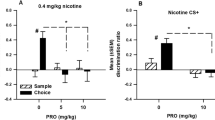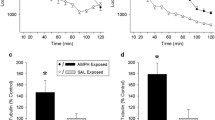Abstract
The non-competitive N-methyl-d-aspartate (NMDA) receptor antagonist, MK-801, has been shown to block the development of sensitization of the behavioral activating effects of amphetamine. Three experiments were designed to determine in rats whether MK-801 had its effects through interference with long-term changes underlying sensitization, per se, or through interference with the development of conditioning of the drug effect to the environment where the drug was given. In experiment 1, conditioning was promoted by explicitly pairing amphetamine (1.5 mg/kg, IP) with the testing environment. In experiment 2, a random-pairing procedure was used to eliminate the possibility of association between the drug and a specific context. Experiment 3 was carried out to assess the duration of the blockade of sensitization by MK-801. The effect of MK-801 (0.25 mg/kg, IP) during amphetamine pre-exposure was studied in tests for conditioning (following saline injections, experiment 1) and in tests for sensitization (following 0.75 mg/kg amphetamine, experiments 1, 2 and 3). It was found in experiment 1 that MK-801 given with amphetamine during the amphetamine pre-exposure phase blocked the development of both conditioning activity and environment-specific sensitization to amphetamine. The results of experiment 2, showing that sensitization to amphetamine was blocked by MK-801 even when conditioning was prevented, suggest that the two effects of MK-801 are independent, and may implicate different sites of action. Experiment 3 showed that the blockade of sensitization by MK-801 was evident in tests made 10 days after pre-exposure to amphetamine, supporting the view that MK-801 interferes with long-term changes underlying sensitization to amphetamine.
Similar content being viewed by others
References
Beninger RJ, Hahn BL (1983) Pimozide blocks establishment but not expression of amphetamine-produced environment-specific conditioning. Science 220:1304–1306
Carlsson M, Carlsson A (1989) The NMDA antagonist MK-801 causes marked locomotor stimulation in monoamine-depleted mice. J Neural Transm 75:221–226
Carlsson M, Carlsson A (1990) Interactions between glutamatergic and monoaminergic systems within the basal ganglia—implications for schizophrenia and Parkinson's disease. TINS 13:272–276
Collingridge GL, Kehl SJ, McLennan H (1983) Excitatory amino acids in synaptic transmission in the Schaffer collateral-commissural pathway of the rat hippocampus. J Physiol (Lond) 334:33–46
Criswell HE, Mueller RA, Breese GR (1990) Long-term D1-dopamine receptor sensitization in neonatal 6-OHDA-lesioned rats is blocked by an NMDA antagonist. Brain Res 512:284–290
Drew KL, Glick SD (1990) Role of D1 and D2 receptor stimulation in sensitization to amphetamine-induced circling behavior and in expression and extinction of the Pavlovian conditioned response. Psychopharmacology 101:465–471
Druhan JP, Rajabi H, Stewart J (1992) Dissociation of the effects of MK-801 on baseline and amphetamine stimulated locomotor activity and dopamine overflow in the nucleus accumbens. Soc Neurosci Abstr 18:720
French ED, Ceci A (1990) Non-competitive N-methyl-D-aspartate antagonists are potent activators of ventral tegmental A10 dopamine neurons. Neurosci Lett 119:159–162
Gerfen CR, Engber TM, Mahan LC, Susel Z, Chase TN, Monsma FJ, Jr, Sibley DR (1990) D1 and D2 dopamine receptor-regulated gene expression of striatonigral and striatopallidal neurons. Science 250:1429–1432
Gerfen CR, McGinty JF, Young WS, III (1991) Dopamine differentially regulates dynorphin, substance P, and enkephalin expression in striatal neurons: in situ hybridization histochemical analysis. J Neurosci 11:1016–1031
Graybiel AM, Moratalla R, Robertson HA (1990) Amphetamine and cocaine induce drug-specific activation of the c-fos gene in striosome-matrix compartments and limbic subdivisions of the striatum. Proc Natl Acad Sci USA 87:6912–6916
Hanson GR, Smiley P, Johnson M, Letter A, Bush L, Gibb J (1989) Response by the neurotensin systems of the basal ganglia to cocaine treatment. Eur J Pharmacol 160:23–30
Iyengar S, Dilworth VM, Mick SJ, Contreras PC, Monahan JB, Rao TS, Wood PL (1990) Sigma receptors modulate both A9 and A10 dopaminergic neurons in the rat brain: functional interaction with NMDA receptors. Brain Res 524:322–326
Kalivas PW, Stewart J (1991) Dopamine transmission in the initiation and expression of drug- and stress-induced sensitization of motor activity. Brain Res Rev 16:223–244
Kalivas PW, Weber B (1988) Amphetamine injection into the A10 dopamine region sensitizes rats to peripheral amphetamine and cocaine. J Pharmacol Exp Ther 245:1095–1102
Karler R, Calder LD, Chaudhry IA, Turkanis SA (1989) Blockade of ‘reverse tolerance’ to cocaine and amphetamine by MK-801. Life Sci 45:599–606
Karler R, Chaudhry IA, Calder LD, Turkanis SA (1990) Amphetamine behavioral sensitization and the excitatory amino acids. Brain Res 537:76–82
Keefe KA, Zigmond MJ, Abercrombie ED (1990) Excitatory amino acid receptor involvement in the regulation of striatal extracellular dopamine. Ann NY Acad Sci 604:614–616
Keefe KA, Zigmond MJ, Abercrombie ED (1992) Extracellular dopamine in striatum: influence of nerve impulse activity in medial forebrain bundle and local glutamatergic input. Neuroscience (in press)
Lindfors N, Brodin E, Tossman U, Segovia J, Ungerstedt U (1989) Tissue levels and in vivo release of tachykinins and GABA in striatum and substantia nigra of rat brain after unilateral striatal dopamine denervation. Exp Brain Res 74:527–534
Lindfors N, Brené S, Herrera-Marschitz M, Persson H (1990) Neuropeptide gene expression in brain is differentially regulated by midbrain dopamine neurons. Exp Brain Res 80:489–500
Mattingly BA, Gotsick JE, Salamanca K (1988) Latent sensitization to apomorphine following repeated low doses. Behav Neurosci 102:553–558
Merchant MK, Bush LG, Gibb JW, Hanson GR (1990) Neurotensin-dopamine interactions in the substantia nigra of the rat brain. J Pharmacol Exp Ther 255:775–780
Miserendino MJD, Sananes CB, Melia KR, Davis M (1990) Blocking of acquisition but not expression of conditioned fear-potentiated startle by NMDA antagonists in the amygdala. Nature 345:716–718
Moghaddam B, Gruen RJ (1991) Do endogenous excitatory amino acids influence striatal dopamine release? Brain Res 544:329–330
Morelli M, Di Chiara G (1990) Stereospecific blockade of N-methyl-d-aspartate transmission by MK 801 prevents priming of SKF 38393-induced turning. Psychopharmacology 101:287–288
Morris RGM, Anderson E, Lynch GS, Baudry M (1986) Selective impairment of learning and blockade of long-term potentiation by an N-methyl-d-aspartate receptor antagonist, AP5. Nature 319:774–776
Muller D, Joly M, Lynch G (1988) Contributions of quisqualate and NMDA receptors to the induction and expression of LTP. Science 242:1694–1697
Price JL, Russchen FT, Amaral DG (1987) The limbic regions. II: The amygdaloid complex. In: Bjorklund A, Hokfelt T, Swanson LW (eds) Handbook of chemical neuroanatomy, vol 5. Integrated systems of the CNS, Part 1. Elsevier, Amsterdam, pp 279–388
Robinson TE, Becker JB (1986) Enduring changes in brain and behavior produced by chronic amphetamine administration: a review and evaluation of animal models of amphetamine psychosis. Brain Res Rev 11:157–198
Singh NA, Bush LG, Gibb JW, Hanson GR (1990) Dopamine-mediated changes in central nervous system neurotensin systems: a role for NMDA receptors. Eur J Pharmacol 187:337–344
Staubli U, Olivier T, DiLorenzo M, Lynch G (1989) Antagonism of NMDA receptors impairs acquisition but not retention of olfactory memory. Behav Neurosci 103:54–60
Stewart J (1992) Conditioned stimulus control of the expression of sensitization of the behavioral activating effects of Opiate and stimulant drugs. In: Gormezano I, Wasserman EA (eds) Learning and memory: behavioral and biological substrates. Erlbaum, Hillside, NJ, pp 129–151
Stewart J, Eikelboom R (1987) Conditioned drug effects. In Iversen LL, Iversen SD, Snyder SH (eds) Handbook of psychopharmacology. Plenum Press, New York, pp 1–57
Stewart J, Vezina P (1988) Conditioning and behavioral sensitization. In: Kalivas PW, Barnes CD (eds) Sensitization in the nervous system. Telford Press, Caldwell, NJ, pp 207–224
Stewart J, Vezina P (1989) Microinjections of SCH-23390 into the ventral tegmental area and substantia nigra pars reticulata attenuate the development of sensitization of the locomotor activating effects of systemic amphetamine. Brain Res 495:401–406
Stewart J, Vezina P (1991) Extinction procedures abolish conditioned stimulus control but spare sensitized responding to amphetamine. Behav Pharmacol 2:65–71
Stewart J, Jakob A, Druhan JP (1992) The non-competitive NMDA antagonist, MK801, blocks the development of sensitization to the locomotor activity effects of apomorphine. Soc Neurosci Abstr 18:1575
Svensson A, Carlsson ML (1992) Injection of the competitive NMDA receptor antagonist AP-5 into the nucleus accumbens of monoamine-depleted mice induces pronounced locomotor stimulation. Neuropharmacology 31:513–518
Verney C, Baulac M, Berger B, Alvarez C, Vigny A, Helle KB (1985) Morphological evidence for a dopaminergic terminal field in the hippocampal formation of young and adult rat. Neuroscience 4:1039–1052
Vezina P, Stewart J (1989) The effect of dopamine receptor blockade on the development of sensitization to the locomotor activating effects of amphetamine and morphine. Brain Res 499:108–120
Vezina P, Stewart J (1990) Amphetamine administered to the ventral tegmental area but not to the nucleus accumbens sensitizes rats to systemic morphine: lack of conditioned effects. Brain Res 516:99–106
Weihmuller FB, O'Dell SJ, Cole BN, Marshall JF (1991) MK-801 attenuates the dopamine-releasing but not the behavioral effects of methamphetamine: an in vivo microdialysis study. Brain Res 549:230–235
Wolf ME, Khansa MR (1991) Repeated administration of MK-801 produces sensitization to its own locomotor stimulant effects but blocks sensitization to amphetamine. Brain Res 562:164–168
Yoshikawa T, Shibuya H, Kaneno S, Toru M (1991) Blockade of behavioral sensitization to methamphetamine by lesion of the hippocampo-accumbal pathway. Life Sci 48:1325–1332
Author information
Authors and Affiliations
Rights and permissions
About this article
Cite this article
Stewart, J., Druhan, J.P. Development of both conditioning and sensitization of the behavioral activating effects of amphetamine is blocked by the non-competitive NMDA receptor antagonist, MK-801. Psychopharmacology 110, 125–132 (1993). https://doi.org/10.1007/BF02246961
Received:
Revised:
Issue Date:
DOI: https://doi.org/10.1007/BF02246961




